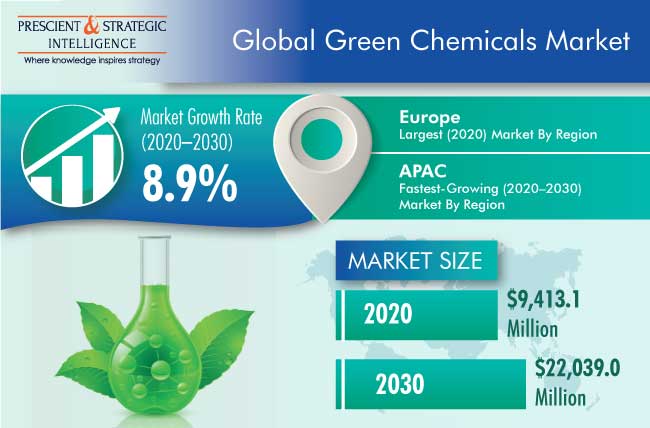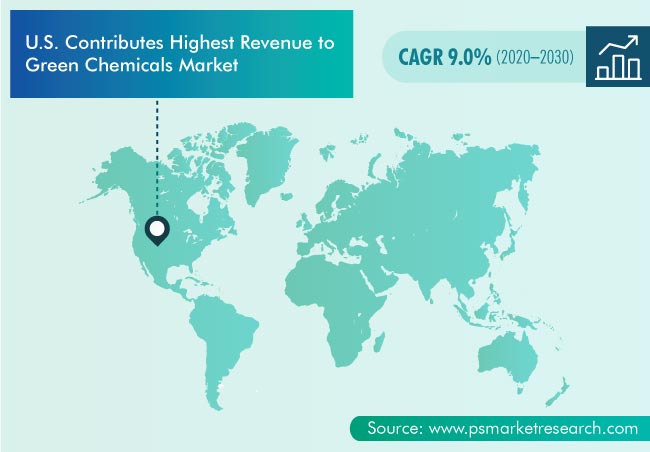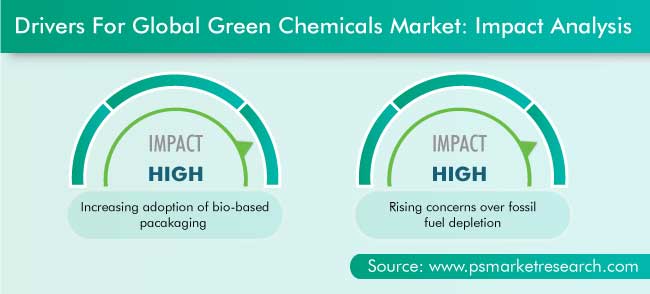Report Code: 12026 | Available Format: PDF | Pages: 171
Green Chemicals Market Research Report: By Product (Bioalcohols, Biopolymers, Biosolvents, Organic Acids), Application (Food & Beverages, Personal Care, Packaging, Automotive, Agriculture) - Global Industry Trends and Demand Forecast to 2030
- Report Code: 12026
- Available Format: PDF
- Pages: 171
- Report Description
- Table of Contents
- Market Segmentation
- Request Free Sample
Market Overview
The global green chemicals market revenue stood at $9,413.1 million in 2020, and it is expected to grow at a CAGR of 8.9% during 2020–2030. The key factors responsible for the growth of the market include the increasing adoption of biobased packaging and rising concerns for fossil fuel depletion.
The COVID-19 pandemic severely impacted several markets across the globe, particularly in China, the U.S., Italy, Spain, and other Western European nations. The pandemic also had a significant impact on the market for green chemicals, majorly attributable to the shutdown of manufacturing facilities in compliance with government regulations, to contain the disease. The shutdown of factories and warehouses caused additional losses to chemical manufacturers as the previously manufactured and stocked chemicals could not be sold due to temporary trade bans and reduced demand.

Bioalchohols Accounted for Dominating Share due to Their Rising Usage in Beverage Production
The bioalcohols category dominated the green chemicals market, both in terms of value and volume, based on product, in 2020. Moreover, it is expected to retain its position during the forecast period. This is majorly attributed to the high-volume usage of bioethanol as an alternative fuel for spark-ignition engines of vehicles. In addition, a significant demand for bioethanol arises for the production of alcoholic beverages, such as beer, vodka, brandy, gin, and whiskey.
Personal Care Sector To Witness Fastest Growth owing to Rising Green Chemicals Usage Here
The personal care category is expected to be the fastest-growing category in the market for green chemicals during the forecast period (2021–2030), based on application. This will majorly be due to the increasing concerns regarding the harmful effects of synthetic chemicals on the skin. Therefore, with the growing adoption of bio-based beauty and personal hygiene products, the demand for green chemicals from the personal sector is expected to increase, particularly in the U.S., Germany, the U.K., China, and India.
European Region Held Largest Share due to Strong Environmental Concerns
Geographically, the European region held the largest shares in the global green chemicals market in 2020, and, further, it is expected to lead the market during the forecast period. This can be attributed to the rising adoption of green chemicals across different industries, including food & beverages, personal care, automotive, and packaging, owing to the strong environmental concerns in the region. In addition, the chemicals industry of the region is increasingly putting focus on the production of green chemicals in order to develop sustainable and eco-friendly solutions.

Increasing Adoption of Bio-Based Packaging Is Driving Market Growth
In recent years, the rising adoption of packaging materials made of renewable sources, such as plant and animal waste, has led to significant growth in the market for green chemicals. This can be attributed to the environmental benefits of bio-based packaging, including its non-toxic nature, requirement for less raw material for production, low production cost, and convenient disposal. With the increase in environmental concerns, the adoption of bio-based packaging materials is likely to witness a rise in the future, which, in turn, is expected to fuel the demand for green chemicals for their production.

Rising Concerns over Fossil Fuel Depletion Are also Propelling Market Growth
Green chemicals are produced using plant or animal waste, which is why they are environment-friendly and non-toxic in nature, which is leading to the growth of the green chemicals market. In addition, they do not pose any threat to the environment, such as the release of harmful particulate matter or sulphur dioxide, unlike fossil fuels. These raw materials for bio-based chemicals are also abundant in nature, unlike fossil fuels, which have limited availability. Therefore, with the rising concerns regarding the rapid depletion of oil and gas reserves, the adoption of green chemicals is expected to increase in the near future.
Market Players Involved in Product Launches to Gain Significant Position
| Report Attribute | Details |
Historical Years |
2015-2020 |
Forecast Years |
2021-2030 |
Base Year (2020) Market Size |
$9,413.1 Million |
Market Size Forecast in 2030 |
$22,039.0 Million |
Forecast Period CAGR |
8.9% |
Report Coverage |
Market Trends, Drivers, and Restraints; Revenue Estimation and Forecast; Segmentation Analysis; Country Breakdown; Impact of COVID-19; Companies’ Strategic Developments; Company Profiling |
Market Size by Segments |
By Product; By Application; By Region |
Market Size of Geographies |
U.S.; Canada; Germany; France; U.K.; Italy; China; Japan; India; South Korea; Brazil, Mexico, Colombia, Saudi Arabia; U.A.E.; South Africa |
Secondary Sources and References (Partial List) |
American Chemical Society; Bio-Based Industries Consortium; Brazilian Chemical Industry Association; European Biomass Industry Association; European Commission; Green Chemistry & Commerce Council; International Energy Agency; Japan Association for International Chemical Information; Organic Trade Association; UK Energy Research Centre; Wageningen University & Research; World Economic Forum |
Explore more about this report - Request free sample
The market is fragmented in nature. Moreover, the players in the green chemicals industry have been involved in product launches in order to attain a significant position. For instance:
- In June 2021, JSW Cement Limited entered the construction chemicals sector with the launch of a new range of green products, which consumes less water during application. It replaces the use of river sand during concreting with screen slag, thereby conserving natural resources and contributing to the prevention of landslides, floods, and air pollution.
- In October 2019, Braskem announced the launch of its new ‘I'm green’ recycled polypropylene in the U.S. With this launch, the company aimed to encompass its full range of circular economy products as part of its commitment to help transform the plastics chain from a linear economy into a circular economy, a concept where materials are used, disposed of, and then recycled in a circular way.
Key Players in Global Green Chemicals Market Are:
-
Arkema Group
-
BASF SE
-
Evonik Industries AG
-
GFBiochemicals Ltd.
-
Koninklijke DSM N.V.
-
Mitsubishi Chemical Corporation
-
Plantic Technologies Limited
-
Toray Industries Inc.
-
Total Corbion PLA
-
Vertec BioSolvents Inc.
Market Size Breakdown by Segment
The global green chemicals market report offers comprehensive market segmentation analysis along with market estimation for the period 2015–2030.
Based on Product
- Bioalcohols
- Biopolymers
- Biosolvents
- Organic Acids
Based on Application
- Food & Beverages
- Personal Care
- Packaging
- Automotive
- Agriculture
Geographical Analysis
- North America
- U.S.
- Canada
- Europe
- Germany
- France
- U.K.
- Italy
- Asia-Pacific (APAC)
- China
- India
- Japan
- South Korea
- Latin America (LATAM)
- Brazil
- Mexico
- Colombia
- Middle East & Africa (MEA)
- Saudi Arabia
- U.A.E.
- South Africa
The market for green chemicals will grow from $9,413.1 million in 2020 to $22,039.0 million by 2030.
Bioalcohols are the largest-selling products in the green chemicals industry.
Europe is the largest market for green chemicals, based on region.
The green chemicals industry is driven by the rising demand for bio-based packaging and concerns regarding the depletion of fossil fuel reserves.
The market for green chemicals is fragmented in nature.
Want a report tailored exactly to your business strategy?
Request CustomizationWant an insight-rich discussion with the report author?
Speak to AnalystOur dedication to providing the most-accurate market information has earned us verification by Dun & Bradstreet (D&B). We strive for quality checking of the highest level to enable data-driven decision making for you
Our insights into the minutest levels of the markets, including the latest trends and competitive landscape, give you all the answers you need to take your business to new heights
With 24/7 research support, we ensure that the wheels of your business never stop turning. Don’t let time stand in your way. Get all your queries answered with a simple phone call or email, as and when required
We take a cautious approach to protecting your personal and confidential information. Trust is the strongest bond that connects us and our clients, and trust we build by complying with all international and domestic data protection and privacy laws